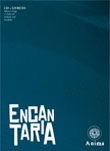The ENCANTARIA musical concert was
awarded by PROAC - State Secretariat of Culture of São Paulo
(series of 6 concerts in the State of São Paulo - year 2012) and
is the winner of the FUNARTE PRIZE OF BRAZILIAN MUSIC, as part
of the ANIMA Group project: "ANIMA 25 YEARS OF MATRIXES OF
BRAZILIAN MUSIC" (series of 06 ENCANTARIA concerts, 6 didactic
concerts and workshops with Universities: UFMG, UDESC, UNESPAR,
UFPR, Carlos Gomes Foundation, Belém, UNESP and UFG). This show
had its international première at the Innovantiqua Festival
, Winterthur, Switzerland, in 2013 and was sponsored by the SESC
SESC of the State of São Paulo for the recording of the CD,
finalized in May of 2015, with launch in 2017 and 2018.
The nucleus of the musical performance, the recording of the CD and the
printing of the book / CD insert commemorative of its 25 YEARS of work, are the
Afro-Brazilian religions with their rituals of ENCOUNTERS, together with the
MILLINGS OF MILLS studied and collected by Mario de Andrade in the First Mission
of Folklore Researches of 1929 in the Northeast of Brazil, contained in the 1st.
Taken from the Dramatic Dances of Brasil collection. The first step towards the
meeting of Anima with the Maranhão Mine Drum and with the Cheganças de Mouros"
of Northeast is the Myth of the King "ENCHANTED" - Dom Sebastião (1554-1578),
his disappearance in the Battle of Alcácer Quibir, in Morocco (August 4, 1578)
and the possibility of his resurgence in the "Shrouded Isle", or in the
"Fortunate Islands", leaving the condition of "Enchanted", from "Covered", to
the condition of "Savior of the World, of the oppressed and of the Nation",
possibility still pulsating in the popular imaginary Brazilian. This Brazilian
popular musical legacy is the source where the entire musical spectacle of
"ENCANTARIA".
It will be in the State of Maranhão, in the Island of Lençóis and in the
Afro-Brazilian rituals of São Luís that the The enchanted king is abundantly
impressed through the touches of the voduns religion's drums. (orixás), as well
as in other popular manifestations, as in the toadas of oxen, in the bumba-meu-
with the star on the forehead that recalls the legend of the charmed bull: "a
great black bull with a bright star on the forehead, which appears on Friday
nights, on the Island of Lençóis "(FERRETTI). They say some that Dom Sebastião
usually appears mainly in June, during the celebrations of the bumba- my-ox, and
in August, the anniversary of the battle of Alcácer-Quibir.
The term "mine drums" refers to the voodoo religion brought by enslaved
Negroes, the "minas" slaves, Sudanese blacks, from the State of Maranhão:
initiatory and sacrificial religion where the entities that are incorporated
into the "initiates" in trance can be the voduns or the enchanted ones. (PRANDI)
According to Mundicarmo Ferretti "the enchanted are people who lived on earth
and disappear mysteriously, seemingly conquering death, and which are believed
to have live in another plane, like King Sebastian." (FERRETTI)
In the communication "Dom Sebastião, the saint and the king in
Enchantment and Maranhão folklore", Sérgio Ferretti sums up the legend as
follows:
It is said that the sand dunes of Lençóis Island have
similarities with the field of Alcácer-Quibir, where El rey
Dom Sebastiao disappeared. Lençóis is considered an
enchanted island, which serves as the home to Dom Sebastião.
His kingdom is hidden in the the bottom of the sea, near
that island. The king lives in his palace submerged and your
ship never finds the route to Portugal. They say that on
Friday nights Dom Sebastião appears on the beach in shape of
a black bull, with a gold star on his forehead. If someone
reaches the star and hurts the bull, the kingdom will be
disenchanted, the city of São Luís will submerge and a city
will appear enchanted with the treasures of the king.
In the same way that ANIMA emphasizes the rituals of Maranhão mine drums,
it will address the Battle of Alcácer Quibir, place of the enchantment
of Dom Sebastião, through the eyes of Moor, subdued by the Catholic Church and
the Portuguese crown, using the repertoire of the Cheganças de Mouros collected
by Mario de Andrade in 1928, which the CD. The additive rhythm and some rhythmic
patterns of the Gnawa of the Maghreb, permeate every spectacle, now as a
framework, sometimes as a "backdrop", highlighting, even in the repertoire of
the Iberian Renaissance and Baroque, the sonorous legacy of these peoples
subdued until today, but strongly present and pulsating in the current Brazilian
sound imagery.
ENCANTARIA results in the collective creation of a musical dramaturgical
script that leads the listener to a contemporary realization of traditional
Brazilian popular music, where the between matrices and between mythical and
historical times are diluted. Consistent with the camerística mission of the
ANIMA Group, ENCANTARIA is constructed based on musicological,
ethnomusicological and organological, but above all, from the stimuli generated
by the encounter between different languages artistic activities. In this sense,
in ENCANTARIA, the ANIMA Group relies on the dialogue and photographer Fernando
Laszlo, who illustrates the CD ENCANTARIA, with its images of deserts and sands,
from the Taklamakan Desert (China), to the sands of the Bahian coast. In the
ENCANTARIA project, part of the stimuli and information about the Battle of
Alcácer Quibir, the emergence of the Portuguese millenarian myth about the Dom
Sebastião and the emergence of this myth in Canudos and in the region of Pedra
Furada, were with the writer WALNICE NOGUEIRA GALVÃO, who suggested the
millenarian theme to the Anima, offered a bibliography on the subject and
produced texts that were, in a collective, debated among artists. Debates on the
transformation of the messianic myth, linked to the imposition of Catholicism
and the extinction of North African Islamism, in a very rich ritual that up to
the present day in the mine houses, in Maranhão, were possible from the
anthropologist Maranhão Mundicarmo Ferretti. That way, in the CD insert we had
the grateful satisfaction of having a text from WALNICE NOGUERIRA GALVÃO and
another text written by MUNDICARMO FERRETTI, about the ritual whose nuclear
repertoire permeates this show / CD.
The research and selection of musical repertoire is carried out by the
members of the ANIMA Group in partnership with CULTURAL ASSOCIATION and ACERVO
MUSICAL CACHUERA! (SP) - led by ethnomusicologist and percussionist PAULO DIAS -
and by the IHU ASSOCIATION of indigenous music - directed by the composer MARLUI
MIRANDA, both musicians also members of the ANIMA Group.
The investigation of the instruments used by the ANIMA Group overflows
the bibliography organism when each group musician dialogues with the artists /
craftsmen, builders of their instruments. Whether these builders of Brazilian
traditions, or constructors (paleomusicologists) of European instruments of the
Middle Ages, the Renaissance and the Baroque, whose originals collections and
museums.
In this way, the CD and the spectacle of the ANIMA Group, "ENCANTARIA",
carry the procedures of collective creation work developed by the ANIMA Group,
over 25 years. This show and CD are performed as part of the celebrations of its
25 years of work together to the music of Brazilian oral tradition and to its
intersections with the music of the ancestors of Brazilians, indigenous,
African, Iberian peninsula.
The creation of arrangements in artistic cooperation between the members
of the Group: Paulo Dias (percussion), Marlui Miranda (singing and percussion),
Gisela Nogueira (Brazilian wire viola), Luiz Fiaminghi (Brazilian fiddle and
medieval vielle), Silvia Ricardino (medieval and Renaissance harp) Valeria
Bittar (historical flutes and indigenous Brazilian flutes) and Cecilia Arellano
(mezzo soprano - guest artist.
BIBLIOGRAPHY
FERRETTI, Mundicarmo. Enchanted and enchanted in Brazilian
folklore. In: IV Seminar on Integrated Actions in Folklore,
São Paulo, 2008.
PRANDI, Reginaldo. In the footsteps of voduns: a drum terreiro
in São Paulo. Chapter published in: MOURA, Carlos Eugênio
Marcondes de (org.). Somavó, tomorrow never ends. São Paulo,
Empório de Produção, 2005. pp. 63-94. </ Blockquote> </ p>






